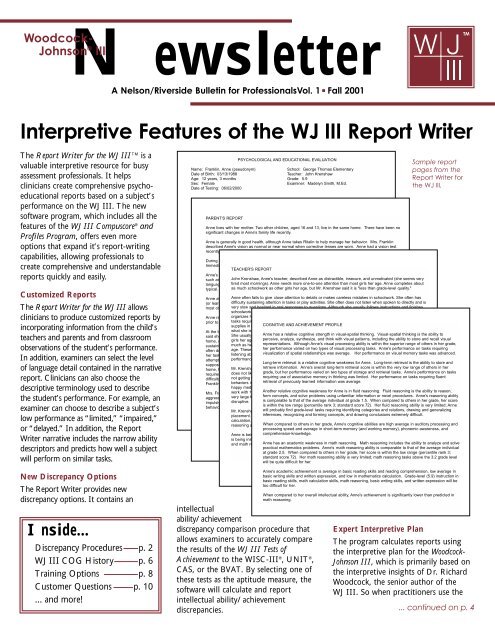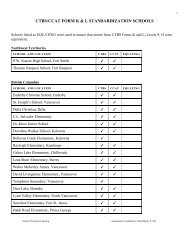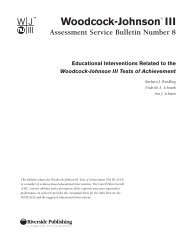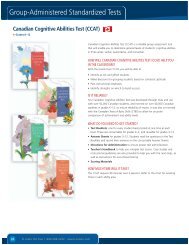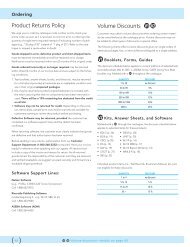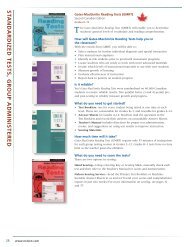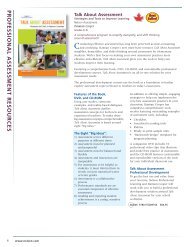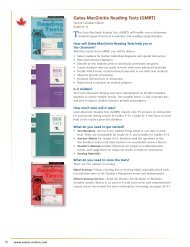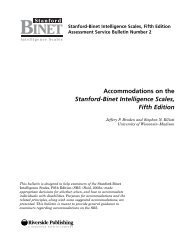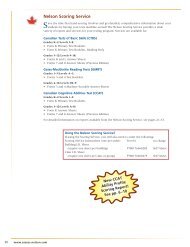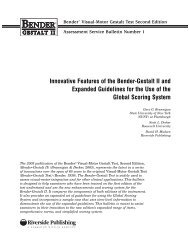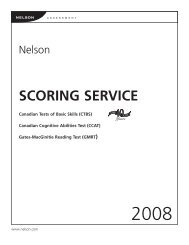Interpretive Features of the WJ III Report Writer - Assessment
Interpretive Features of the WJ III Report Writer - Assessment
Interpretive Features of the WJ III Report Writer - Assessment
Create successful ePaper yourself
Turn your PDF publications into a flip-book with our unique Google optimized e-Paper software.
<strong>WJ</strong> <strong>III</strong> Newsletter–Vol. 1The Woodcock-Johnson Tests <strong>of</strong>Cognitive Abilities: A Brief Historyby Fredrick A. Schrank, Ph.D., ABPPWhen <strong>the</strong> <strong>WJ</strong> <strong>III</strong> Tests <strong>of</strong> CognitiveAbilities was published in 2001, itbecame <strong>the</strong> third generation <strong>of</strong> one <strong>of</strong><strong>the</strong> most well-known and widely usedmeasures <strong>of</strong> intellectual abilities. Theoriginal version <strong>of</strong> this test was Part One:Tests <strong>of</strong> Cognitive Ability <strong>of</strong> <strong>the</strong>Woodcock-Johnson Psycho-EducationalBattery (<strong>WJ</strong>) (Woodcock & Johnson,1977). In 1989 <strong>the</strong> authors revised <strong>the</strong>battery and produced a second edition,<strong>the</strong> Woodcock-Johnson Tests <strong>of</strong> CognitiveAbility–Revised (<strong>WJ</strong>-R COG) (Woodcock& Johnson, 1989).1977 Woodcock-JohnsonThe Woodcock-Johnson Psycho-EducationalBattery, published in 1977, was a singlebattery with three parts—Part One: Tests<strong>of</strong> Cognitive Ability, Part Two: Tests <strong>of</strong>Achievement, and Part Three: Tests <strong>of</strong>Interest Level.The first cognitive battery containedtwelve tests that measured both verbaland nonverbal functions. The testsmeasured cognitive abilities falling on acontinuum from lower processes, such assimple operations, to higher processes,such as complex mental operations. Thefirst test developed was Visual-AuditoryLearning (Woodcock, 1958), which wasdesigned to predict how well someonecould learn to read. Analysis-Syn<strong>the</strong>siswas developed next, and it measured aperson’s ability to learn ma<strong>the</strong>matics. Dr.Woodcock constructed <strong>the</strong> rest <strong>of</strong> <strong>the</strong>cognitive tests to measure a variety <strong>of</strong>broad and complex cognitive abilities.Dr. Woodcock began developing <strong>the</strong><strong>WJ</strong> in 1973. Instead <strong>of</strong> applying an overall<strong>the</strong>oretical model, he developed <strong>the</strong> testfollowing a scientific-empirical methodthat used a number <strong>of</strong> controlledexperiments to measure learning abilities.The battery was standardized from 1976through 1977. After standardization,Dr. Woodcock analyzed <strong>the</strong> factors andclusters and defined <strong>the</strong> following fourbroad areas <strong>of</strong> functioning that <strong>the</strong> batterymeasured: Knowledge-Comprehension,Reasoning-Thinking, Memory-Learning,and Discrimination-Perception.Dr. Richard WoodcockIn <strong>the</strong> 1970s, when people beganviewing <strong>the</strong> term intelligence quotient(IQ) in a negative light, <strong>the</strong> term BroadCognitive Ability (BCA) was introducedto refer to an individual’s overallcognitive score. The BCA was derived byweighting <strong>the</strong> twelve cognitive testsdifferentially instead <strong>of</strong> equally to give astatistically better estimate <strong>of</strong> a person’soverall cognitive ability.1989 Woodcock-Johnson–RevisedIn 1989 <strong>the</strong> Woodcock-Johnson Psycho-Educational Battery–Revised waspublished. The <strong>WJ</strong>-R was divided intotwo separate batteries: <strong>the</strong> Tests <strong>of</strong>Cognitive Ability and <strong>the</strong> Tests <strong>of</strong>Achievement. The <strong>the</strong>ory underlying <strong>the</strong>revised edition was based on Dr.Woodcock’s insights into John Horn’s1985 paper on <strong>the</strong> operationalrepresentation <strong>of</strong> Gf-Gc <strong>the</strong>ory (Horn,1991). Dr. Woodcock planned andorganized <strong>the</strong> Tests <strong>of</strong> CognitiveAbility–Revised to better approximateHorn’s Gf-Gc <strong>the</strong>ory. To accomplishthis, he developed ten new cognitivetests for <strong>the</strong> <strong>WJ</strong>-R COG. These newtests measured <strong>the</strong> following seven broadabilities identified in Gf-Gc <strong>the</strong>ory:Long-term retrieval (Glr), short-termmemory (Gsm), processing speed (Gs),auditory processing (Ga), visualprocessing (Gv) comprehensionknowledge(Gc), and fluid reasoning(Gf). As a result, <strong>the</strong> <strong>WJ</strong>-R Tests <strong>of</strong>Cognitive Ability became <strong>the</strong> primarybattery <strong>of</strong> tests for measuring <strong>the</strong> sevenbroad abilities identified in Gf-Gc <strong>the</strong>ory.In a 1990 paper (Woodcock, 1990),Dr. Woodcock showed that Gf-Gc <strong>the</strong>orycan be used to describe <strong>the</strong> factorstructure <strong>of</strong> o<strong>the</strong>r intelligence tests if abattery’s tests are compared to o<strong>the</strong>r testsin a study that is broad enough and deepenough to identify all <strong>the</strong> major Gf-Gcfactors. And soon people began usingGf-Gc <strong>the</strong>ory to analyze and interpreto<strong>the</strong>r intelligence tests as well. Thishelped establish Gf-Gc <strong>the</strong>ory as a majordescriptor <strong>of</strong> human intellectual abilitiesand a standard for evaluating tests <strong>of</strong>intelligence (McGrew & Flanagan, 1998).2001 Woodcock-Johnson <strong>III</strong>In 1993, John Carroll developed athree-stratum <strong>the</strong>ory that categorizedhuman cognitive abilities into a threestratumhierarchy. In <strong>the</strong> first level(Stratum 1), Carroll identified 69specific, or narrow, abilities that weresimilar to <strong>the</strong> Well Replicated CommonFactor (WERCOF) abilities identified byHorn and associates in 1979 (Ekstrom,French, and Harman, 1979). ThenCarroll grouped those narrow abilitiesinto broader categories <strong>of</strong> cognitiveability. This second level (Stratum 2)closely resembled Horn’s Gf-Gc factors.The third level (Stratum 3) identifies ageneral intellectual ability (g) factor.Carroll published this <strong>the</strong>ory in <strong>the</strong>book, Human Cognitive Abilities: ASurvey <strong>of</strong> Factor-Analytic Studies(Carroll, 1993, 1998).The Cattell-Horn-Carroll researchbecame known as CHC <strong>the</strong>ory. The6
<strong>WJ</strong> <strong>III</strong> Newsletter–Vol. 1Table 1.CHC Theory AbilitiesMeasured by <strong>the</strong> <strong>WJ</strong> <strong>III</strong>COGStratum I Stratum II Stratum <strong>III</strong>Lexical Knowledge/Language Development Comprehension/Knowledge General Intellectual AbilityGeneral (verbal) InformationAssociate MemoryIdeational FluencyLong-Term RetrievalVisualizationSpatial RelationsSpatial ScanningSpeech-Sound DiscriminationResistance to Auditory Stimulus DistortionPhonetic CodingInductionSequential ReasoningSemantic Processing SpeedPerceptual SpeedNaming FacilityMemory SpanVisual-Spatial ThinkingAuditory ProcessingFluid ReasoningProcessing SpeedShort-Term Memory<strong>WJ</strong> <strong>III</strong> authors used this <strong>the</strong>ory tocreate broader factors so <strong>the</strong> factorscores could be generalized to o<strong>the</strong>rsituations, thus making <strong>the</strong>m more valid.To accomplish this, for most factors, <strong>the</strong>authors created <strong>the</strong> factor score bycombining two or more tests <strong>of</strong>qualitatively different narrow abilities. Abroader measure <strong>of</strong> each factor providesa more valid CHC factor score because<strong>the</strong> practical implications <strong>of</strong> anindividual’s cluster score performancecan be generalized to more situations.For example, in <strong>the</strong> <strong>WJ</strong> <strong>III</strong>, <strong>the</strong> Gvcluster is composed <strong>of</strong> a measure <strong>of</strong>visualization (Test 3: Spatial Relations)and a measure <strong>of</strong> memory (Test 13:Picture Recognition). Table 1 shows <strong>the</strong>broad and narrow CHC abilities that <strong>the</strong><strong>WJ</strong> <strong>III</strong> COG measures.The <strong>WJ</strong> <strong>III</strong> Tests <strong>of</strong> Cognitive Abilitiesmeasures broad CHC factor scores toprovide diagnostic information to analyzewithin-individual variability. But in caseswhere <strong>the</strong> individual tests in a cluster differsignificantly, <strong>the</strong> qualitative differencesbetween <strong>the</strong> narrow abilities measured byeach test can provide additional valuableinterpretive information.Although some intelligence scholars,including Horn, do not recognize apsychometric g as a psychological entity,many pr<strong>of</strong>essionals have indicated <strong>the</strong>need for a general intellectual abilityscore. So <strong>the</strong> <strong>WJ</strong> <strong>III</strong> authors added afirst-principal component (g) score to <strong>the</strong>Tests <strong>of</strong> Cognitive Abilities to answer thisneed. The general intellectual ability, orGIA, score in <strong>the</strong> <strong>WJ</strong> <strong>III</strong> is different from<strong>the</strong> full-scale scores in o<strong>the</strong>r intelligencetests. In o<strong>the</strong>r tests, <strong>the</strong> full-scale scoresare only an arithmetic mean <strong>of</strong> all tests orsubtests in <strong>the</strong> battery. While in <strong>the</strong><strong>WJ</strong> <strong>III</strong>, <strong>the</strong> factors that make up <strong>the</strong> GIAscore are weighted based on how mucheach contributes to <strong>the</strong> g.ReferencesCarroll, J. B. (1993). Human cognitiveabilities: A survey <strong>of</strong> factor-analyticstudies. New York: Cambridge.Carroll, J. B. (1998). Human cognitiveabilities: A critique. In J. J. McArdle& R. W. Woodcock (Eds), Humancognitive abilities in <strong>the</strong>ory andpractice (pp. 5–24). Mahwah, NJ:Lawrence Erlbaum.Ekstrom, R. B., French, J. W., &Harman, M. H. (1979). Cognitivefactors: Their identification andreplication. Multivariate BehavioralResearch Monographs, 79(2).Horn, J. (1991). Measurement <strong>of</strong>intellectual capabilities: A review <strong>of</strong><strong>the</strong>ory. In McGrew, K. S., Werder, J.K., and Woodcock, R. W., <strong>WJ</strong>-RTechnical Manual (pp. 197–232).Itasca, IL: Riverside.McGrew, K. S., & Flanagan, D. P.(1998). The intelligence test deskreference. Boston: Allyn & Bacon.Woodcock, R. W. (1958). Anexperimental prognostic test forremedial readers. Journal <strong>of</strong>Educational Psychology, 49, 23–27.Woodcock, R. W. (1990). Theoreticalfoundations <strong>of</strong> <strong>the</strong> <strong>WJ</strong>-R measures <strong>of</strong>cognitive ability. Journal <strong>of</strong>Psychoeducational <strong>Assessment</strong>, 8,231–258.Woodcock, R. W., & Johnson, M. B.(1977). Woodcock-Johnson Psycho-Educational Battery. Itasca, IL:Riverside.Woodcock, R. W., & Johnson, M. B.(1989). Woodcock-Johnson Psycho-Educational Battery–Revised. Itasca,IL: Riverside.7
<strong>WJ</strong> <strong>III</strong> Newsletter–Vol. 1Several Training Options Available to <strong>WJ</strong> <strong>III</strong> UsersExaminers can develop <strong>the</strong>ir testingcompetency on <strong>the</strong> Woodcock-Johnson <strong>III</strong>using several different types <strong>of</strong> trainingmaterials.<strong>WJ</strong> <strong>III</strong> University Training PackageThis training package is designed to helpuniversity pr<strong>of</strong>essors and trainingpr<strong>of</strong>essionals teach o<strong>the</strong>rs how to use<strong>the</strong> new Woodcock-Johnson <strong>III</strong>. The<strong>WJ</strong> <strong>III</strong> Training CD-ROM can be usedwith ei<strong>the</strong>r Windows ® or Macintosh ®operating systems and contains videoclips <strong>of</strong> administration and scoringprocedures as well as pre- and post-teststo help examiners who are learning <strong>the</strong><strong>WJ</strong> <strong>III</strong> target <strong>the</strong>ir strengths andweaknesses. This training packageincludes presentation materials, such asslides and handouts, in PowerPointformat, that instructors and trainers canedit and customize.(Code: 9-23635)<strong>WJ</strong> <strong>III</strong> Self-Study Training PackageThis package is designed to helpexaminers learn to administer and use<strong>the</strong> new <strong>WJ</strong> <strong>III</strong> on <strong>the</strong>ir own. The<strong>WJ</strong> <strong>III</strong> Self-Study CD-ROM also can beused with ei<strong>the</strong>r Windows or Macintoshoperating systems. It contains video clips<strong>of</strong> test administration and scoringprocedures and pre-and post-tests, but itdoes not include presentation materials.(Code: 9-23640)<strong>WJ</strong> <strong>III</strong> Training Video PackagesThere are two different training videopackages—one for <strong>the</strong> <strong>WJ</strong> <strong>III</strong> Tests <strong>of</strong>Cognitive Abilities and one for <strong>the</strong><strong>WJ</strong> <strong>III</strong> Tests <strong>of</strong> Achievement. The videosare in VHS format and contain testadministration clips, generaladministration rules, scoring procedures,and interpretive options, such as age/grade pr<strong>of</strong>iles. They also feature <strong>the</strong>authors discussing important aspects <strong>of</strong><strong>the</strong> tests.(Code: 9-23645 – Achievement,Code: 9-23647 – Cognitive)Examiner Training WorkbooksThe University Training Package and<strong>the</strong> Self-Study Training Package containcopies <strong>of</strong> both <strong>the</strong> Cognitive andAchievement Examiner TrainingWorkbooks. A copy <strong>of</strong> <strong>the</strong> ExaminerTraining Workbook for <strong>the</strong> appropriate<strong>WJ</strong> <strong>III</strong> battery is included in eachTraining Video Package. Theseworkbooks contain step-by-stepexamples showing how to establishbasals and ceilings, score items,calculate raw scores, obtain estimatedage and grade equivalents, and read <strong>the</strong><strong>WJ</strong> <strong>III</strong> s<strong>of</strong>tware score report. Theworkbooks also contain practiceexercises and reproducible checkliststhat can be used as self-study orobservation tools. These workbooks arealso available for separate purchase inpackages <strong>of</strong> five.(Code: 9-23533 – Achievement,Code: 9-23534 – Cognitive)<strong>WJ</strong> <strong>III</strong> WorkshopsMany workshops are scheduled eachyear. Costs may vary. To get on our listto be notified <strong>of</strong> upcoming workshopsin your area, email us atvicki.vanderburgh@nelson.com.<strong>WJ</strong> <strong>III</strong> Delayed Recall Tests Best Interpreted With z ScoresThe Woodcock-Johnson <strong>III</strong> uses z scores toreport <strong>the</strong> discrepancy between predictedand actual scores on delayed recall (DR)tests (Visual-Auditory Learning in <strong>the</strong><strong>WJ</strong> <strong>III</strong> Tests <strong>of</strong> Cognitive Abilities andStory Recall in <strong>the</strong> <strong>WJ</strong> <strong>III</strong> Tests <strong>of</strong>Achievement). Examiners can administerdelayed recall tests anywhere from 30minutes to 8 days after administering <strong>the</strong>initial test.The <strong>WJ</strong> <strong>III</strong> Compuscore and Pr<strong>of</strong>ilesProgram calculates <strong>the</strong> predicted DRscore using <strong>the</strong> subject’s age or grade, <strong>the</strong>initial test score, and <strong>the</strong> time intervalbetween when <strong>the</strong> initial and delayedtests were administered. The programinterprets <strong>the</strong> delayed recall test based on<strong>the</strong> difference between <strong>the</strong> predicted DRscore and <strong>the</strong> actual DR score. Then itevaluates this difference like an ability/achievement discrepancy to see if <strong>the</strong>subject’s DR score is within normal limitsfor his or her age or grade, initial score,and delay interval.A z score indicates <strong>the</strong> number <strong>of</strong>standard deviation units that separate<strong>the</strong> predicted and actual scores. On <strong>the</strong>s<strong>of</strong>tware report, a z score correspondsto <strong>the</strong> Discrepancy SD score reportedin <strong>the</strong> Discrepancies section anddiscussed in <strong>the</strong> Examiner’s Manuals. Anegative z score indicates that <strong>the</strong>actual delayed score was less thanpredicted, and a positive z scoreindicates that <strong>the</strong> actual delayed scorewas higher than predicted. Scoresbetween. –1.00 (PR = 16) and +1.00(PR = 84) are <strong>of</strong>ten considered within<strong>the</strong> normal range.8
<strong>WJ</strong> <strong>III</strong> Newsletter–Vol. 1<strong>WJ</strong> <strong>III</strong> <strong>Interpretive</strong> Books Available Soon<strong>Assessment</strong> pr<strong>of</strong>essionals will soon havefour new resource books available to help<strong>the</strong>m interpret <strong>the</strong> Woodcock-Johnson <strong>III</strong>.Look for <strong>the</strong> Essentials <strong>of</strong> <strong>WJ</strong> <strong>III</strong>Cognitive Abilities <strong>Assessment</strong> and <strong>the</strong>Essentials <strong>of</strong> <strong>WJ</strong> <strong>III</strong> Tests <strong>of</strong> Achievement<strong>Assessment</strong>. These two books are part <strong>of</strong><strong>the</strong> Essentials series <strong>of</strong> primers publishedby John Wiley. Each <strong>of</strong> <strong>the</strong> <strong>WJ</strong> <strong>III</strong> bookspresents a concise overview <strong>of</strong> <strong>the</strong>administration, scoring, and interpretation<strong>of</strong> <strong>the</strong> featured battery. The clinicalapplications and case studies chaptersprovide information not found in anyo<strong>the</strong>r published resource. The authors <strong>of</strong><strong>the</strong> cognitive essentials book are FredrickA. Schrank, Dawn P. Flanagan, RichardW. Woodcock, and Jennifer T. Mascolo.Nancy Ma<strong>the</strong>r, Barbara J. Wendling, andRichard W. Woodcock are <strong>the</strong> authors <strong>of</strong><strong>the</strong> achievement essentials book. Alan andNadeen Kaufman are <strong>the</strong> sponsors andeditors <strong>of</strong> this series <strong>of</strong> short books.Woodcock-Johnson <strong>III</strong>: Recommendationsand <strong>Report</strong>s, authored by Nancy Ma<strong>the</strong>rand Lynne Jaffe, is ano<strong>the</strong>r John Wileypublication that will be available soon.<strong>WJ</strong> <strong>III</strong> examiners will find this volumeuseful in converting <strong>WJ</strong> <strong>III</strong> test resultsinto meaningful recommendations,measurable goals, and concrete objectivesfor monitoring student progress. Thebook includes numerous examples <strong>of</strong>effective diagnostic reports, summariesthat can be attached to a methods report,and techniques for implementingrecommendations effectively.ReferencesMa<strong>the</strong>r, N., & Jaffe, L. (2001). Woodcock-Johnson <strong>III</strong>: Recommendations and<strong>Report</strong>s. New York: Wiley.Schrank, F. A., Flanagan, D. P,Woodcock, R. W., & Mascolo, J. T.(2001). Essentials <strong>of</strong> <strong>WJ</strong> <strong>III</strong> CognitiveAbilities <strong>Assessment</strong>. New York: Wiley.Wendling, B. J., Ma<strong>the</strong>r, N. &Woodcock, R. W. (2001). Essentials <strong>of</strong><strong>WJ</strong> <strong>III</strong> Tests <strong>of</strong> Achievement <strong>Assessment</strong>.New York: Wiley.Contact John Wiley & Sons Canada(1-800-567-4797) for <strong>the</strong>se books.Contact Nelson Thomson Learning(1-800-268-2222) for test materials.<strong>WJ</strong> <strong>III</strong> Tests <strong>of</strong> Cognitive Abilities Materials GrantsTo date, three Canadian Universities havetaken advantage <strong>of</strong> <strong>the</strong> <strong>WJ</strong><strong>III</strong> Tests <strong>of</strong>Cognitive Abilities Materials GrantsProgram to School Psychology trainingprograms. These grants are sponsored byNelson Thomson Learning, TheRiverside Publishing Company andMeasurement/Learning/Consultants.MLC is a company founded by <strong>the</strong>author <strong>of</strong> <strong>the</strong> <strong>WJ</strong> <strong>III</strong>, Dr. RichardWoodcock. The purpose <strong>of</strong> <strong>the</strong> grants isto encourage <strong>the</strong> development <strong>of</strong> modelcourses in intellectual assessment, using<strong>the</strong> <strong>WJ</strong> <strong>III</strong> as <strong>the</strong> primary or co-primaryinstrument. Each grant recipient receives12 <strong>WJ</strong> <strong>III</strong> Cognitive complete kits. Theschools participating are:University <strong>of</strong> SaskatchewanDr. Don Sakl<strong>of</strong>skeUniversity <strong>of</strong> British ColumbiaDr. William McKeeMount Saint Vincent UniversityDr. Frederick FrenchIn 2001, Nelson and each participatinguniversity hosted a <strong>WJ</strong> <strong>III</strong> workshop. Toapply for <strong>the</strong> grant, your SchoolPsychology department head shouldcontact peter.cameron@nelson.com forfur<strong>the</strong>r details.Universities using <strong>the</strong> <strong>WJ</strong> <strong>III</strong> or o<strong>the</strong>rtest materials as part <strong>of</strong> <strong>the</strong>ir academicprogram or research activities may beeligible for a discount <strong>of</strong> up to 30%.Some restrictions apply. Contact Nelsonfor fur<strong>the</strong>r information.9
<strong>WJ</strong> <strong>III</strong> Newsletter–Vol. 1IAP WebsiteIs a ValuableResourceDr. Kevin McGrew,Director <strong>of</strong> <strong>the</strong>Institute for AppliedPsychometricsThe Institute for Applied Psychometrics(IAP) website at www.IAPsych.com isone place to look for <strong>WJ</strong> <strong>III</strong> interpretiveassessment resource information. The sitewas created by <strong>WJ</strong> <strong>III</strong> co-author, KevinMcGrew, to link psychological,psychometric, measurement, andstatistical <strong>the</strong>ory and methods withapplied practice to solve problems inpsychology and education. The site has aspecial focus on <strong>the</strong> use <strong>of</strong> <strong>the</strong> Cattell-Horn-Carroll Theory <strong>of</strong> CognitiveAbilities in intelligence test developmentand interpretation. To date, almost16,000 users have visited <strong>the</strong> IAP homeweb page. The IAP mailing list now has232 subscribers, and <strong>the</strong> CHC DiscussionList currently has 167 subscribers.If you haven’t visited <strong>the</strong> site recently,you’ll note that it has been updated andnow has a new look and improvedorganization. The table <strong>of</strong> contents wasreorganized into broad categories. ACHC discussion listserv was added, <strong>the</strong>virtual bookstore was expanded, andusers can now download free PowerPointslides for educational and trainingpurposes. The IAP site also postsworkshop agendas and registration.The Favorite IAP Links section <strong>of</strong> <strong>the</strong>site contains links to sites withinformation on topics such as tests,training, special education issues,intelligence, disabilities, central auditoryprocessing disorders, statistics, dataanalysis, neurology, and neuropsychology.... continued on p. 11Customers Are Asking . . .Q: Are <strong>the</strong> audio cassettes for <strong>the</strong> <strong>WJ</strong> <strong>III</strong> taped tests available on CD-ROM?A: The <strong>WJ</strong> <strong>III</strong> audio cassettes are not currently available on CD-ROM.However, this project is in development, and <strong>the</strong> audio materials shouldbe available on CD-ROM within a year.Q: When scoring Reading Fluency, why is <strong>the</strong> score calculated by subtracting<strong>the</strong> number incorrect from <strong>the</strong> number correct? It seems like students arebeing punished for guessing.A: You are correct. This method <strong>of</strong> scoring reduces <strong>the</strong> “guess factor.” SinceReading Fluency requires subjects to mark each item Yes or No, subjectscan guess and have a 50 percent chance <strong>of</strong> getting <strong>the</strong> items correct. So<strong>the</strong> test is scored by evaluating <strong>the</strong> correct and incorrect responses within<strong>the</strong> range <strong>of</strong> attempted items. But because <strong>the</strong> norms are based on thisprocedure, subjects are not punished.Q: Why don’t <strong>the</strong> scoring tables on <strong>the</strong> <strong>WJ</strong> <strong>III</strong> Test Records match <strong>the</strong>scores on <strong>the</strong> scoring s<strong>of</strong>tware report?A: Scores don’t always match because <strong>the</strong> scoring tables on <strong>the</strong> <strong>WJ</strong> <strong>III</strong> TestRecords use estimated scores. The scoring s<strong>of</strong>tware calculates scores usingadditional available variables, such as time limits, test sections, ageequivalents,grade equivalents, and delay times, that cannot be built into<strong>the</strong> printed scoring tables. This is ano<strong>the</strong>r reason for <strong>the</strong> <strong>WJ</strong> <strong>III</strong> to becomputer-scored only.Q: On Planning, is <strong>the</strong> subject allowed to correct his or her answers byerasing?A: No. If <strong>the</strong> subject makes a mistake on <strong>the</strong> Planning sample items, you canerase <strong>the</strong> subject’s incorrect tracing and ask him or her to try <strong>the</strong> sampleitem again. This is <strong>the</strong> only erasing that is allowed on this test. Thesubject is not allowed to erase, or even pick up his or her pencil from <strong>the</strong>paper, while completing <strong>the</strong> Planning test items.Q: When do I enter an X in <strong>the</strong> <strong>WJ</strong> <strong>III</strong> Compuscore and Pr<strong>of</strong>iles Programscoring s<strong>of</strong>tware?A: For tests that contain groups <strong>of</strong> items (Story Recall, StoryRecall–Delayed, Understanding Directions, and Planning), enter <strong>the</strong>number <strong>of</strong> points (or errors) in <strong>the</strong> scoring s<strong>of</strong>tware for each group <strong>of</strong>items you administer. Enter an X (not a zero) to indicate groups <strong>of</strong> itemsyou did not administer. Do not enter an X in a test if you did notadminister it. Simply skip over that test and leave it blank when youenter data in <strong>the</strong> computer s<strong>of</strong>tware program.Q: When I tried to enter <strong>the</strong> date <strong>of</strong> testing in <strong>the</strong> <strong>WJ</strong> <strong>III</strong> Compuscore, <strong>the</strong>numbers all ran toge<strong>the</strong>r and wouldn’t go into <strong>the</strong> month, day, and yearfields correctly.A: To complete any <strong>of</strong> <strong>the</strong> date fields in <strong>the</strong> scoring s<strong>of</strong>tware, you must typein <strong>the</strong> month and <strong>the</strong> day as two-digit numbers and <strong>the</strong> year as a fourdigitnumber. For example, if your date <strong>of</strong> testing is April 1, 2001, youwould type 04/01/2001.10
<strong>WJ</strong> <strong>III</strong> Newsletter–Vol. 1Q: I administered <strong>the</strong> <strong>WJ</strong> <strong>III</strong> Tests <strong>of</strong> Cognitive Abilities over two days. On<strong>the</strong> first day I entered a date in <strong>the</strong> Date <strong>of</strong> Testing field. On <strong>the</strong> secondday, when I administered Visual-Auditory Learning (a test with a Date <strong>of</strong>Testing field), <strong>the</strong> <strong>WJ</strong> <strong>III</strong> Compuscore would not let me enter that day’sdate but kept defaulting to <strong>the</strong> first date <strong>of</strong> administration.A: The <strong>WJ</strong> <strong>III</strong> Compuscore is programmed so that all tests with date fieldsdefault to <strong>the</strong> first date <strong>of</strong> administration. You will need to enter <strong>the</strong> firstdate <strong>of</strong> administration in all date fields or change <strong>the</strong> date in <strong>the</strong> first Date<strong>of</strong> Testing field to match your second date <strong>of</strong> testing.If you have to adjust <strong>the</strong> testing date for Visual-Auditory Learningand/or Story Recall, <strong>the</strong>n remember to adjust <strong>the</strong> testing date for <strong>the</strong>delayed recall tests (Visual-Auditory Learning–Delayed and/or StoryRecall–Delayed) to maintain <strong>the</strong> correct delay interval. The s<strong>of</strong>twareincorporates <strong>the</strong> delay time when calculating <strong>the</strong> predicted delayed recallscore, so it is important that that interval is correct.Q: What is <strong>the</strong> difference in scores between <strong>the</strong> 2-minute and <strong>the</strong> 7-minuteversions <strong>of</strong> Writing Fluency?A: This test should almost always be given for <strong>the</strong> full 7-minute time limit.The score <strong>the</strong> s<strong>of</strong>tware calculates for a 2-minute sample is a predictedestimate <strong>of</strong> how <strong>the</strong> subject would do if he or she were to test for 7minutes.Q: How do you score false basals and ceilings?A: There is only one true basal and one true ceiling. Therefore, you shoulduse <strong>the</strong> lowest basal, or Item 1, and <strong>the</strong> highest ceiling, or <strong>the</strong> last item.Basal and ceiling rules limit <strong>the</strong> span <strong>of</strong> items administered while allowingan examiner to estimate, with high probability, <strong>the</strong> score a subject wouldhave obtained if he or she had taken all <strong>the</strong> items in <strong>the</strong> test.Q: Why don’t I get standard scores for <strong>the</strong> delayed recall tests?A: The delayed recall tests give z scores instead <strong>of</strong> standard scores because<strong>the</strong> delayed test is comparing a subject to himself or herself, not to <strong>the</strong>norms. For more information on z scores, see <strong>the</strong> article, “<strong>WJ</strong> <strong>III</strong> DelayedRecall Tests Best Interpreted With z Scores.”Q: How do I get <strong>the</strong> score report to show z scores for <strong>the</strong> delayed tests(Visual-Auditory Learning–Delayed and Story Recall–Delayed)?A: To show z scores on <strong>the</strong> score report, click on <strong>the</strong> Options menu, selectProgram Options, and click on <strong>the</strong> <strong>Report</strong> Options tab. In <strong>the</strong>Additional Score Column section, choose “z score,” and click OK. Thez scores will <strong>the</strong>n show in <strong>the</strong> last column <strong>of</strong> <strong>the</strong> score report.IAP WEBSITE... continued from p. 10The site also contains <strong>the</strong> IAPReference Database, a literature trackingand database reference system that tracksall journals in <strong>the</strong> Current Contents onDiskette system as well as a variety <strong>of</strong>pr<strong>of</strong>essional journals, like SchoolPsychology Review, <strong>Assessment</strong>,Psychological Methods, and Intelligence, ona weekly basis. The database containsreferences to articles on topics likeintelligence <strong>the</strong>ory, neuropsychology,reading instruction/intervention,learning disabilities, genetics, cognitiveabilities, mental retardation, specialeducation, multivariate statistics, and IRTprocedures. It also includes a “recentliterature <strong>of</strong> interest” page.REPORT WRITER... continued from p. 5ConclusionWith <strong>the</strong> <strong>Report</strong> <strong>Writer</strong> for <strong>the</strong> <strong>WJ</strong> <strong>III</strong>,examiners can spend a minimal amount<strong>of</strong> time inputting data and informationand reap maximum interpretive benefits.The program syn<strong>the</strong>sizes test scores,checklist feedback, and discrepancyinformation and quickly producesaccurate narratives to help assessmentpr<strong>of</strong>essionals write comprehensivepsycho-educational or educationalevaluations.Q: In <strong>the</strong> last section <strong>of</strong> Sound Awareness (Reversal), <strong>the</strong> examiner presentsboth sample items using <strong>the</strong> individual sounds. But what about Items 4through 9?A: Items 4 through 9 in <strong>the</strong> Reversal section <strong>of</strong> Sound Awareness are not on<strong>the</strong> audio cassette. The examiner should say <strong>the</strong>se items as whole words.The subject is <strong>the</strong>n supposed to say <strong>the</strong> whole word backwards (creatingano<strong>the</strong>r word) as a correct response.... continued on back page11
<strong>WJ</strong> <strong>III</strong> Newsletter–Vol. 1ASBs: More Tools for <strong>the</strong> <strong>WJ</strong> <strong>III</strong> ToolboxIf you woul like more information on <strong>the</strong>Woodcock-Johnson <strong>III</strong>, a series <strong>of</strong><strong>Assessment</strong> Service Bulletins (ASBs)provides technical <strong>WJ</strong> <strong>III</strong> resourceinformation. ASBs 1, 2, and 3 are currentlyavailable, and ASB 4 is in development.ASB Number 1 compares <strong>the</strong> <strong>WJ</strong> <strong>III</strong>Tests <strong>of</strong> Cognitive Abilities to <strong>the</strong> Wechslerintelligence scales (<strong>the</strong> Wechsler AdultIntelligence Scale ® –Third Edition, <strong>the</strong>Wechsler Intelligence Scale forChildren ® –Third Edition, and <strong>the</strong>Wechsler Preschool and Primary Scale <strong>of</strong>Intelligence TM –Revised). The ASB consists<strong>of</strong> a series <strong>of</strong> tables that concisely showcomparisons between <strong>the</strong> <strong>WJ</strong> <strong>III</strong> COGand <strong>the</strong> Wechslers in <strong>the</strong> following fiveareas:■ content features■ administration features■ interpretation features■ technical features■ coverage <strong>of</strong> Cattell-Horn-Carroll(CHC) broad and narrow cognitiveabilitiesThese comparisons may help cliniciansprovide better test interpretation andbetter assess variations in test performance.ASB Number 2 provides technicalinformation on <strong>the</strong> <strong>WJ</strong> <strong>III</strong>. It gives abrief, but comprehensive summary <strong>of</strong><strong>the</strong> <strong>WJ</strong> <strong>III</strong> Technical Manual,highlighting <strong>the</strong> procedures used todevelop and validate <strong>the</strong> <strong>WJ</strong> <strong>III</strong>,including standardization information,sampling characteristics, normsconstruction, reliability statistics, andvalidity information.ASB Number 3 discusses <strong>the</strong> <strong>WJ</strong> <strong>III</strong>discrepancy procedures and how to use<strong>the</strong>m to identify and diagnose learningdisabilities. See <strong>the</strong> “Educated Guesses: AGuide to Choosing <strong>WJ</strong> <strong>III</strong> DiscrepancyProcedures” article for detailed informationabout <strong>the</strong> <strong>WJ</strong> <strong>III</strong> discrepancy procedures.ASB Number 4 will be available soon.It will include a step-by-step procedurefor calculating ability/achievementdiscrepancies when using <strong>the</strong> WISC-<strong>III</strong>with <strong>the</strong> <strong>WJ</strong> <strong>III</strong> Tests <strong>of</strong> Achievement.The procedure outlined corrects for <strong>the</strong>effects <strong>of</strong> regression to <strong>the</strong> mean. Thecorrelations that are used in <strong>the</strong> ASB arebased on a broad sample <strong>of</strong> individualsranging in age from 6 to 17. (Thesediscrepancy calculations are automated in<strong>the</strong> <strong>Report</strong> <strong>Writer</strong> for <strong>the</strong> <strong>WJ</strong> <strong>III</strong>.)Similar ASBs will be made available forcalculating ability/achievementdiscrepancies between <strong>the</strong> UNIT and <strong>the</strong><strong>WJ</strong> <strong>III</strong> Tests <strong>of</strong> Achievement and <strong>the</strong> CASand <strong>the</strong> <strong>WJ</strong> <strong>III</strong> Tests <strong>of</strong> Achievement.Copies <strong>of</strong> all ASBs are available at:http://assess.nelson.comCUSTOMERS ARE ASKING... continued from p. 9Q:Why is only Form B <strong>of</strong> <strong>the</strong>achievement test available in Canada?A: When Nelson and Riverside reviewed<strong>the</strong> two achievement batteries (FormsA and B) <strong>of</strong> <strong>the</strong> new test, it was clearthat Form B was <strong>the</strong> most internationalin its content. It was determined thatCanadian items would be created formany <strong>of</strong> <strong>the</strong> questions in <strong>the</strong> AppliedProblems test <strong>of</strong> Form B to make <strong>the</strong>test appropriate for use in Canada. Noo<strong>the</strong>r changes were deemed to benecessary. However, Form A <strong>of</strong> <strong>the</strong> <strong>WJ</strong><strong>III</strong> contains much more U.S.-specificcontent, and as such it will be moredifficult to create a version appropriatefor use in Canada. It is anticipated thata Canadian version <strong>of</strong> <strong>the</strong> Form Aachievement test will be available at alater date.Q:Are <strong>the</strong>re Canadian norms for <strong>the</strong><strong>WJ</strong> <strong>III</strong>?A: As part <strong>of</strong> <strong>the</strong> <strong>WJ</strong> <strong>III</strong> test developmentprocess, an equating study wasdesigned and undertaken to determineif unique Canadian norms were neededfor <strong>the</strong> <strong>WJ</strong> <strong>III</strong> COG and <strong>WJ</strong> <strong>III</strong> ACH.This study involved 334 Englishspeakingschool-aged children, ingrades 1-13, selected from threegeographical areas in Canada (WesternCanada, Central Canada, and <strong>the</strong>Maritime Provinces). Communitieswere sampled by census region andtype <strong>of</strong> community. Standardizationequatingdata were obtained from sixprovinces. Communities were targetedfor selection based on <strong>the</strong>characteristics <strong>of</strong> geographicdistribution, size <strong>of</strong> community, andSES characteristics (high, average, andlow SES communities). Catholicschools were also included in <strong>the</strong>equating sample to fur<strong>the</strong>r represent across section <strong>of</strong> <strong>the</strong> community. Thirtyfourschools were included in <strong>the</strong>study. As a concurrent validity measure,<strong>the</strong> WISC <strong>III</strong> was administered to 106<strong>of</strong> <strong>the</strong> individuals included in <strong>the</strong> <strong>WJ</strong><strong>III</strong> Canadian sample.1120 Birchmount Road, Toronto, ON M1K 5G4 • (416) 752-9448 or 1-800-268-2222 • Fax (416) 752-8101 or 1-800-430-4445Email: inquire@nelson.com • Internet: www.nelson.com


